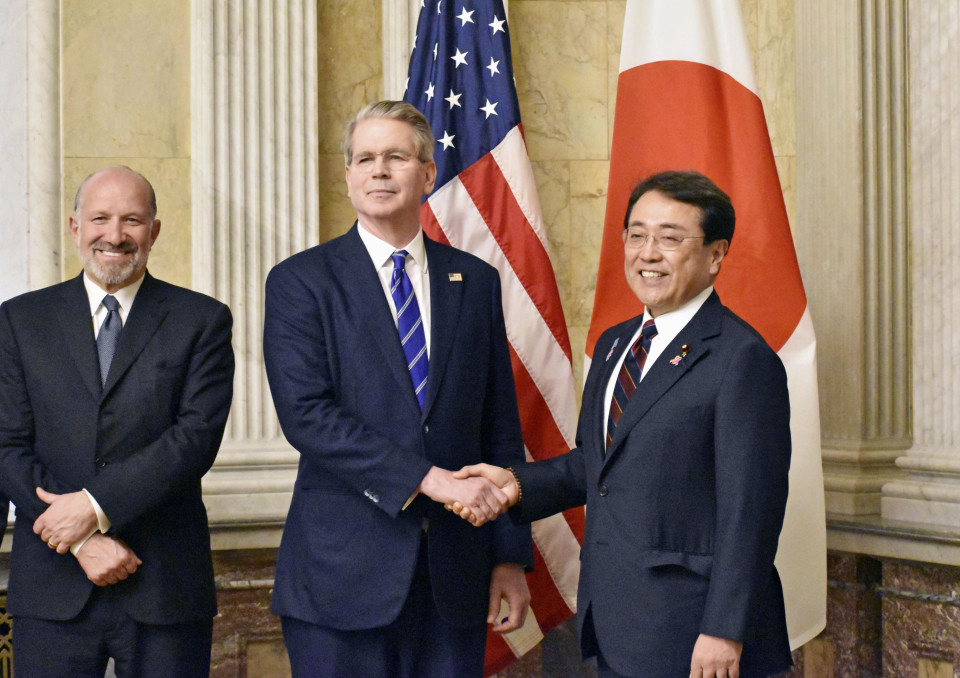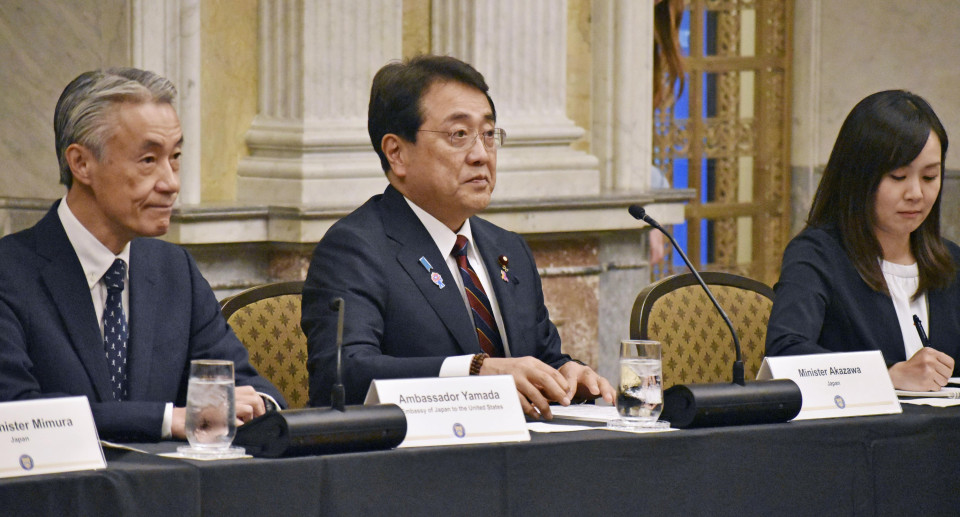Japan and the United States on Thursday agreed to hasten tariff talks after making some progress in laying the groundwork for expanding bilateral trade with the aim of reaching a “mutually beneficial deal” as early as June.
After meeting with Treasury Secretary Scott Bessent and other U.S. Cabinet members in Washington, Japan’s chief negotiator Ryosei Akazawa told reporters that they had agreed to hold intensive ministerial discussions from mid-May onward after starting Friday to sort out points of contention at the working level.
Akazawa said they had managed to deepen discussions on topics such as nontariff barriers and expanding bilateral trade and economic security cooperation, although he stopped short of disclosing details.
“A deal can only be struck when everything is agreed, so it is meaningless to say how far we have progressed,” he said.

Japan’s chief tariff negotiator Ryosei Akazawa (R) and U.S. Treasury Secretary Scott Bessent (C) shake hands ahead of their talks in Washington on May 1, 2025, accompanied by U.S. Commerce Secretary Howard Lutnick. (Pool photo)(Kyodo) ==Kyodo
While stressing that Japan has no intention of negotiating in a way that would be detrimental to its national interests and that nothing is fixed, when asked about the possibility of the Japanese and U.S. leaders striking some kind of deal in June, he said, “It’d be good if we can enter that phase.”
Japanese Prime Minister Shigeru Ishiba and U.S. President Donald Trump could meet bilaterally when Canada chairs this year’s Group of Seven summit in mid-June.
Akazawa, Japan’s minister in charge of economic revitalization, said neither side brought up issues related to defense spending or currency rates during the meeting, which was also joined by Commerce Secretary Howard Lutnick and Trade Representative Jamieson Greer and lasted more than two hours.
The Japanese delegation was hoping to hear more details about U.S. priorities and narrow the scope of the tariff talks — which formally kicked off two weeks ago — when Trump made an unscheduled appearance and suggested that Japan, which hosts over 50,000 U.S. troops on its territory, increase defense spending.
The latest meeting came two days after Trump eased the impact of his new 25 percent tariffs on the auto industry by allowing carmakers producing vehicles in the United States to claim some reimbursements.
Despite the relief, Akazawa said he again urged the Trump administration to remove the auto and other tariffs it has imposed in recent months, rocking the global trading order and sparking fears of a significant economic slowdown.
Aiming for a give-and-take negotiating process, he was expected to offer a package of proposals to the U.S. side. It may have included increased purchases of U.S. corn and soybeans to help counteract the decline of U.S. exports of the two crops to China amid heightened trade tensions between Washington and Beijing.
The United States is already the largest source of Japanese imports of corn and soybeans.
China was the biggest importer of American soybeans and a key trading partner for corn in 2024, according to U.S. Agriculture Department data.

Japan’s chief negotiator Ryosei Akazawa (C) attends the second round of tariff talks with senior U.S. officials in Washington on May 1, 2025. (Pool photo)(Kyodo) ==Kyodo
But China customs data showed that in March, imports of corn and soybeans from the United States fell respectively by 99 percent and 11 percent from a year earlier in value terms, as the world’s two largest economies engage in a tit-for-tat trade war.
Japan is also considering expanding tariff-free imports of U.S.-grown rice, with Trump aiming to reduce his country’s trade deficits and create better-paying jobs.
Other potential proposals include allowing more imported cars eligible to simplified safety and environmental screening process, given that Trump has persistently claimed that American car brands are unpopular in Japan because of its nontariff barriers, according to officials familiar with the matter.
As a bargaining chip, the officials had said Japan could also show its readiness to cooperate in resurrecting the shipbuilding capacity of the United States, a goal Trump has pledged to achieve amid China’s increasing dominance of the industry.
Among major U.S. trading partners, the Trump administration has prioritized striking early tariff deals with India, Japan and South Korea, the three countries it views as strategically important for the United States to have the upper hand over China in the Indo-Pacific region.
Akazawa last visited Washington on April 16 and met with Trump in the Oval Office for 50 minutes before taking part in a meeting with Bessent, Lutnick and Greer.
The Trump administration’s new 24 percent tariffs on goods imported from Japan have been paused until early July under a 90-day reprieve of its so-called reciprocal duties targeted at dozens of trading partners.
But Japan, along with other countries, continues to be hit by a universal tariff of 10 percent and the new levies on cars and other sector-based tariffs.
Related coverage:
40% of Japan prefectures offer financial aid over U.S. tariffs: poll
No U.S. push for Japan to prop up yen in tariff talks
U.S. has no specific currency targets in Japan tariff talks: Bessent